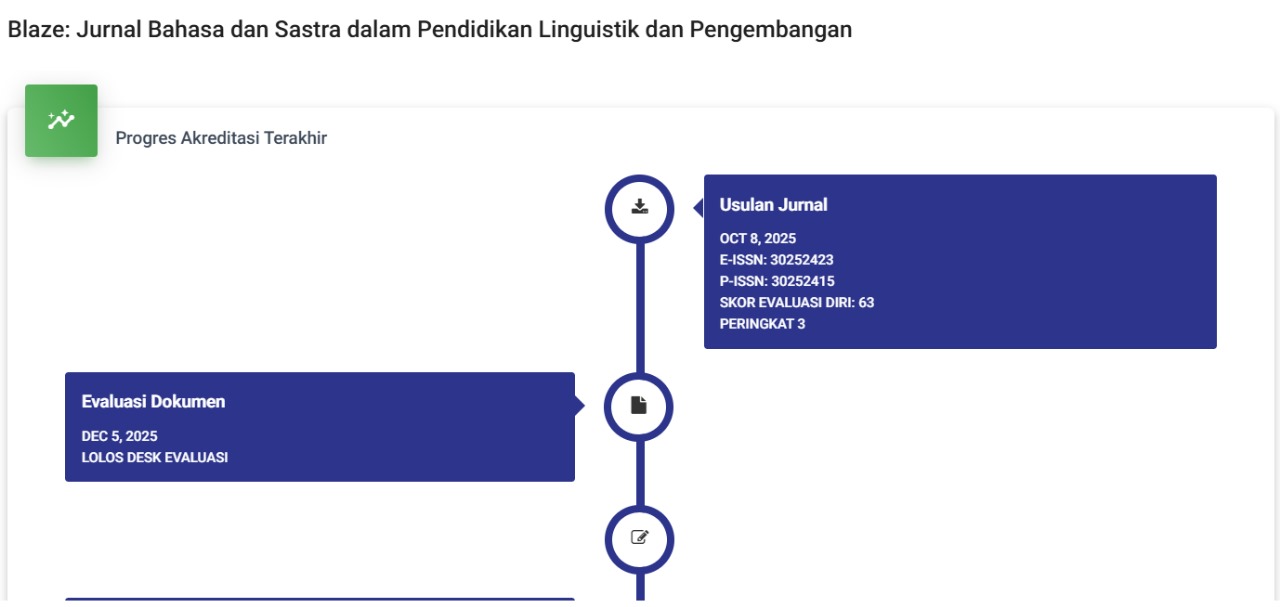Analisis Tokoh Utama dalam Film Miracle In Cell No 7
Sebuah Kajian Psikoanalisis Jacques Lacan
DOI:
https://doi.org/10.59841/blaze.v2i3.1580Keywords:
Film, Miracle in Cell No.7, PsychoanalysisAbstract
Describing real, imaginary, and symbolic analysis in Miracle in Cell No. 7 using Jacques Lacan's psychoanalytic theory was the goal of this research. The research method used is qualitative descriptive. The instrument used is the documentation of the film. Data collection techniques are used to study libraries, recording and recording techniques that cover scenes, clips, durations, and setting aspects. Data analysis techniques are performed consisting of reducing data that emerges from the records of research objects, displaying data in the form of narratives, and verification by drawing conclusions. The results of the research showed that in the real phase, the visible protagonist showed deep affection for his daughter, depicting a warm father-child relationship. The imaginary phase, which marks the child's self-identification process through the mirror phase where unfulfilled desires can lead to a feeling of separation from parents that shows the great hope of parents for their daughters to be successful and happy. This dream shows Dodo's great desire for his family and the imaginative attraction to find meaning and purpose in a difficult life.
References
Ahmadi, A. (2015). Psikologi sastra. Surabaya: Unesa University Press.
Ali, M. (2010). Psikologi film: Membaca film lewat psikoanalisis Lacan-Zizek. Jakarta: Fakultas Film dan Televisi IKJ.
Daming, S., & Al Barokah, E. J. (2022). Tinjauan hukum dan hak asasi manusia terhadap peran keluarga dalam perlindungan anak. YUSTISI, 9(2).
Dewi, K. S. (2012). Kesehatan mental. Semarang: Upt Undip Press Semarang.
Endaswara, S. (2004). Metodologi sastra: Epistemologi, model, teori, dan aplikasi. Yogyakarta: Pustaka Widyatama.
Fadilla, A. N., Puspitasari, L., Wijiono, A., Wiharnik, D. T., Ramadhani, S. D., & Setiawati, R. (2023). Argopuro: Jurnal Multidisiplin Ilmu Bahasa, 1(1), 1-14.
Kevinia, C., Aulia, S., & Astari, T. (2022). Analisis teori semiotika Roland Barthes dalam film Miracle in Cell No. 7 versi Indonesia. Journal of Communication Studies and Society, 1(2), 38-43.
Kholiq, A. (2018). Representasi propaganda dalam film Miracle in Cell No. 7 (Analisis semiotika Roland Barthes) (Doctoral dissertation, Universitas Muhammadiyah Sidoarjo).
Lestari, S., & Amaliana, N. (2020). Peran ayah sebagai orang tua tunggal dalam pengasuhan anak. Jurnal Sains Psikologi Hal, 1, 14.
Manderes, A., Al Katuuk, U. M. K., & Polii, I. J. (2022). Nilai moral keluarga dalam film “Miracle in Cell No. 07” karya Lee Hwan Kyung dan implikasinya pada pembelajaran sastra. Kompetensi, 2(9), 1666-1684.
Ngewa, H. M. (2021). Peran orang tua dalam pengasuhan anak. EDUCHILD (Journal of Early Childhood Education, 1(1), 96-115.
Wati, M. L. K., Rohman, F., & Yuniawan, T. (2023). Analisis semiotika Roland Barthes dan nilai moral dalam film pendek Tilik 2018 karya Wahyu Agung Prasetya. Jurnal Onoma: Pendidikan, Bahasa, dan Sastra, 9(2), 1306-1315.
Zahara, E. (2018). Representasi maskulinitas dalam film Miracle in Cell No. 7 (Analisis semiotika John Fiske). Jurnal Network Media, 1(1).
Downloads
Published
How to Cite
Issue
Section
License
Copyright (c) 2024 BLAZE : Jurnal Bahasa dan Sastra dalam Pendidikan Linguistik dan Pengembangan

This work is licensed under a Creative Commons Attribution-ShareAlike 4.0 International License.








